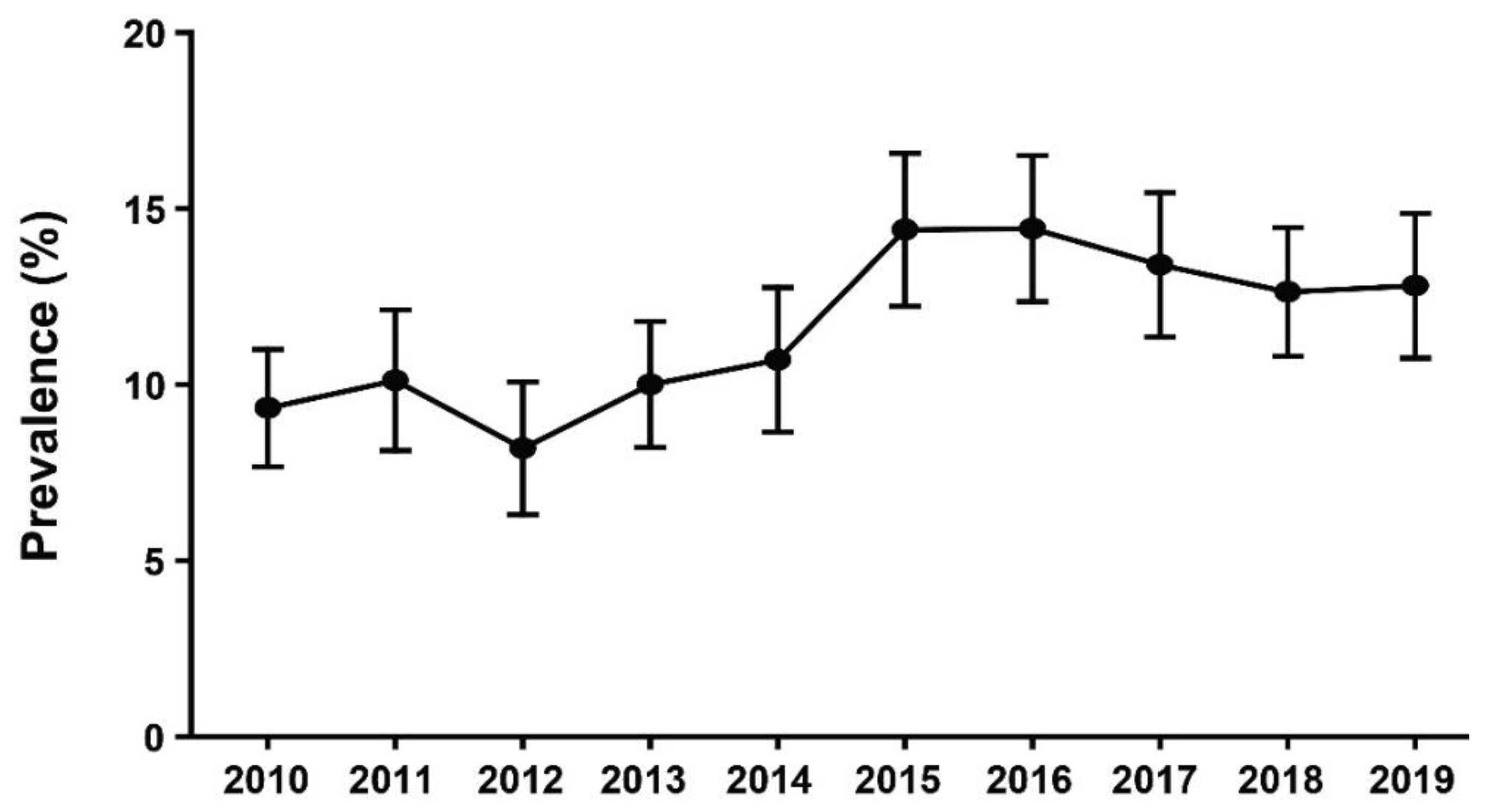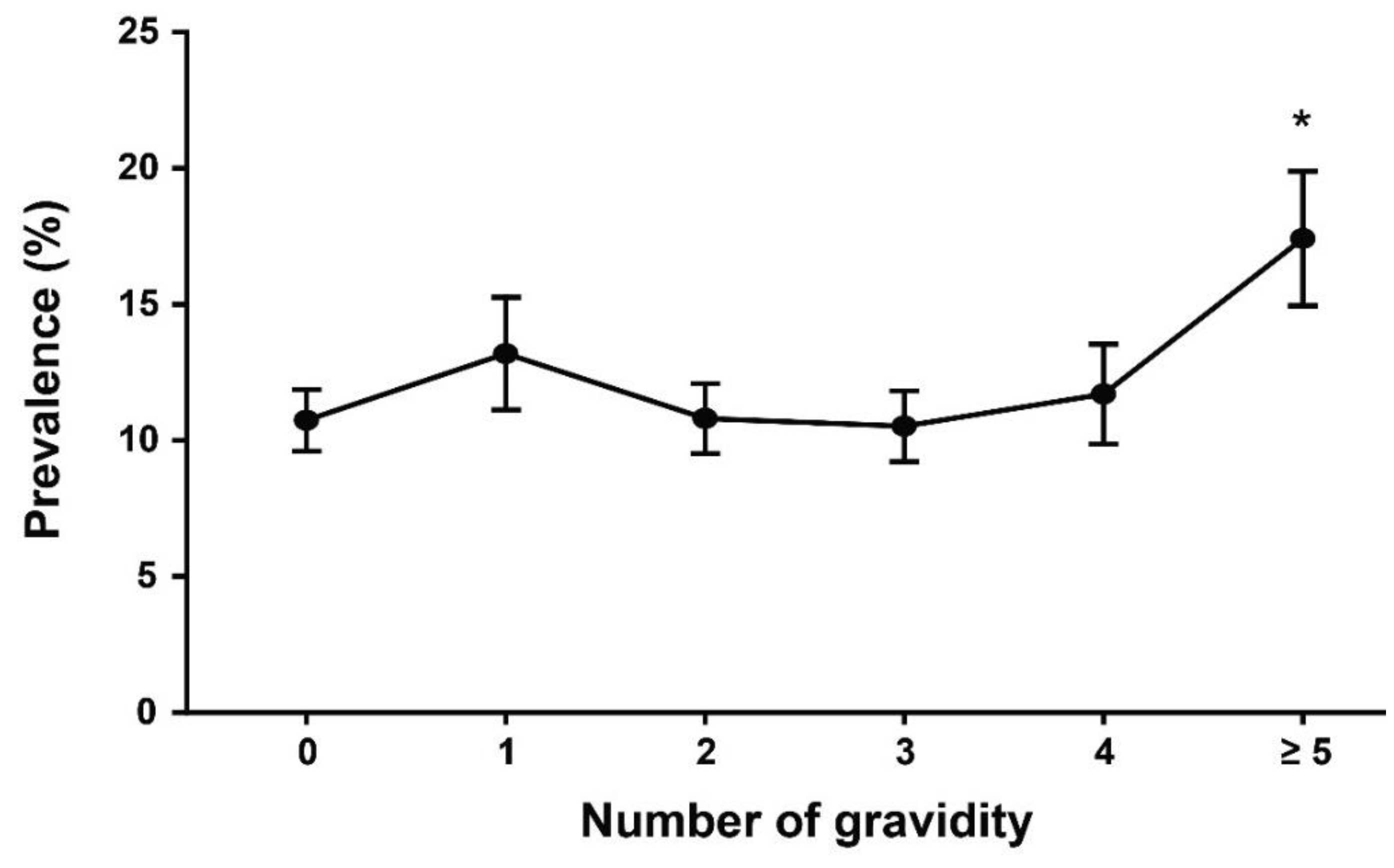Trends and Factors Associated with Oral Contraceptive Use among Korean Women
Abstract
1. Introduction
2. Methods
2.1. Study Population
2.2. Variable Definitions
2.3. Statistical Analysis
3. Results
4. Discussion
5. Conclusions
Author Contributions
Funding
Institutional Review Board Statement
Informed Consent Statement
Data Availability Statement
Conflicts of Interest
References
- Alkema, L.; Kantorova, V.; Menozzi, C.; Biddlecom, A. National, regional, and global rates and trends in contraceptive prevalence and unmet need for family planning between 1990 and 2015: A systematic and comprehensive analysis. Lancet 2013, 381, 1642–1652. [Google Scholar] [CrossRef]
- Benagiano, G.; Bastianelli, C.; Farris, M. Contraception today. Ann. N. Y. Acad. Sci. 2006, 1092, 1–32. [Google Scholar] [CrossRef]
- Contraceptive Use by Method. 2019. Available online: https://www.un.org/development/desa/pd/sites/www.un.org.development.desa.pd/files/files/documents/2020/Jan/un_2019_contraceptiveusebymethod_databooklet.pdf (accessed on 12 May 2021).
- Mansour, D.; Inki, P.; Gemzell-Danielsson, K. Efficacy of contraceptive methods: A review of the literature. Eur. J. Contracept. Reprod. Health Care 2010, 15, 4–16. [Google Scholar] [CrossRef]
- World Contraceptive Use. 2020. Available online: https://www.un.org/en/development/desa/population/publications/dataset/contraception/wcu2020.asp (accessed on 12 May 2021).
- Mohammed, A.; Woldeyohannes, D.; Feleke, A.; Megabiaw, B. Determinants of modern contraceptive utilization among married women of reproductive age group in North Shoa Zone, Amhara Region, Ethiopia. Reprod. Health 2014, 11, 13. [Google Scholar] [CrossRef]
- Apanga, P.A.; Adam, M.A. Factors influencing the uptake of family planning services in the Talensi District, Ghana. Pan Afr. Med. J. 2015, 20, 10. [Google Scholar] [CrossRef]
- New, J.R.; Cahill, N.; Stover, J.; Gupta, Y.P.; Alkema, L. Levels and trends in contraceptive prevalence, unmet need, and demand for family planning for 29 states and union territories in India: A modelling study using the Family Planning Estimation Tool. Lancet Glob. Health 2017, 5, e350–e358. [Google Scholar] [CrossRef]
- Siddiqui, M.; Fatima, K.; Ali, S.N.; Fatima, M.; Naveed, W.; Siddiqui, F.; Naqvi, T.; Khan, S.; Amin, M.; Liaquat, A.; et al. Prevalence and predictors of contraception usage in Karachi, Pakistan. Cureus 2020, 12, e11265. [Google Scholar] [CrossRef] [PubMed]
- Letamo, G.; Navaneetham, K. Levels, trends and reasons for unmet need for family planning among married women in Botswana: A cross-sectional study. BMJ Open 2015, 5, 1–11. [Google Scholar] [CrossRef] [PubMed]
- Debebe, S.; Limenih, M.A.; Biadgo, B. Modern contraceptive methods utilization and associated factors among reproductive aged women in rural Dembia District, Northwest Ethiopia: Community based cross-sectional study. Int. J. Reprod. Biomed. 2017, 15, 367. [Google Scholar] [CrossRef]
- Wulifan, J.K.; Mazalale, J.; Kambala, C.; Angko, W.; Asante, J.; Kpinpuo, S.; Kalolo, A. Prevalence and determinants of unmet need for family planning among married women in Ghana-a multinomial logistic regression analysis of the GDHS, 2014. Contracept. Reprod. Med. 2019, 4, 2. [Google Scholar] [CrossRef]
- Gueye, A.; Speizer, I.S.; Corroon, M.; Okigbo, C.C. Belief in family planning myths at the individual and community levels and modern contraceptive use in urban Africa. Int. Perspect. Sex. Reprod. Health 2015, 41, 191–199. [Google Scholar] [CrossRef] [PubMed]
- Park, E.Y.; Han, K.H.; Chung, T.H.; Kim, N.Y.; Lee, J.M.; Choi, S.J.; Kim, J.K. Association between reproductive span and sarcopenia. Int. J. Environ. Res. Public Health 2020, 18, 154. [Google Scholar] [CrossRef] [PubMed]
- Speroff, L.; DeCherney, A. Evaluation of a new generation of oral contraceptives. The Advisory Board for the New Progestins. Obstet. Gynecol. 1993, 81, 1034–1047. [Google Scholar] [PubMed]
- Paton, D.M. Drospirenone: A novel progestogen used as an oral contraceptive without an estrogen component. Drugs Today 2020, 56, 321–328. [Google Scholar] [CrossRef]
- Kaplan, B. Desogestrel, norgestimate, and gestodene: The newer progestins. Ann. Pharmacother. 1995, 29, 736–742. [Google Scholar] [CrossRef]
- Yasui, T.; Ideno, Y.; Shinozaki, H.; Kitahara, Y.; Nagai, K.; Hayashi, K. JNHS Research Group. Prevalence of the use of oral contraceptives and hormone replacement therapy in Japan: The Japan Nurses’ Health Study. J. Epidemiol. in press. 2020. [Google Scholar] [CrossRef]
- Lundberg, V.; Tolonen, H.; Stegmayr, B.; Kuulasmaa, K.; Asplund, K. WHO MONICA Project. Use of oral contraceptives and hormone replacement therapy in the WHO MONICA project. Maturitas 2004, 48, 39–49. [Google Scholar] [CrossRef]
- Rashed, A.N.; Hsia, Y.; Wilton, L.; Ziller, M.; Kostev, K.; Tomlin, S. Trends and patterns of hormonal contraceptive prescribing for adolescents in primary care in the UK. J. Fam. Plann. Reprod. Health Care 2015, 41, 216–222. [Google Scholar] [CrossRef]
- A Study on Factors of Childbirth Experience Affecting Contraceptive Practices among Married Women in Childbearing Age. 2020. Available online: http://www.riss.kr/link?id=T15528919 (accessed on 16 June 2021).
- Lee, M.J.; Lee, T.R.; Lee, S.J.; Jang, J.S.; Kim, E.J. Machine learning-based data mining method for sentiment analysis of the Sewol ferry disaster’s effect on social stress. Front. Psychiatry 2020, 11, 505673. [Google Scholar] [CrossRef]
- Yang, H.J.; Kim, G.; Lee, K.; Lee, J.; Cheong, H.K.; Choi, B.Y.; Lee, S.Y. Changes in the levels of depressive symptoms and anxiety in Ansan city after the 2014 Sewol ferry disaster. J. Affect. Disord. 2018, 241, 110–116. [Google Scholar] [CrossRef]
- Yang, H.J.; Cheong, H.K.; Choi, B.Y.; Shin, M.H.; Yim, H.W.; Kim, D.H.; Kim, G.; Lee, S.Y. Community mental health status six months after the Sewol ferry disaster in Ansan, Korea. Epidemiol. Health 2015, 37, e2015046. [Google Scholar] [CrossRef]
- Woo, H.; Cho, Y.; Shim, E.; Lee, K.; Song, G. Public trauma after the Sewol ferry disaster: The role of social media in understanding the public mood. Int. J. Environ. Res. Public Health 2015, 12, 10974–10983. [Google Scholar] [CrossRef]
- Freed, B.; Hillman, S.; Shantikumar, S.; Bick, D.; Dale, J.; Gauly, J. The impact of disasters on contraception in OECD member countries: A scoping review. Eur. J. Contracept. Reprod. Health Care 2021, 26, 429–438. [Google Scholar] [CrossRef] [PubMed]
- Garbers, S.; Correa, N.; Tobier, N.; Blust, S.; Chiasson, M.A. Association between symptoms of depression and contraceptive method choices among low-income women at urban reproductive health centers. Matern. Child. Health J. 2010, 14, 102–109. [Google Scholar] [CrossRef] [PubMed]
- Kurita, N. Association of the great east Japan earthquake and the Daiichi nuclear disaster in Fukushima city, Japan, with birth rates. JAMA Netw. Open 2019, 2, e187455. [Google Scholar] [CrossRef] [PubMed]
- King, L.A.; Michels, K.A.; Graubard, B.I.; Trabert, B. Trends in oral contraceptive and intrauterine device use among reproductive-aged women in the US from 1999 to 2017. Cancer Causes Control. 2021, 32, 587–595. [Google Scholar] [CrossRef] [PubMed]
- Lara, L.A.; Abdo, C.H. Age at time of initial sexual intercourse and health of adolescent girls. J. Pediatric Adolesc. Gynecol. 2016, 29, 417–423. [Google Scholar] [CrossRef] [PubMed]
- Hiscock, R.; Bauld, L.; Amos, A.; Fidler, J.A.; Munafò, M. Socioeconomic status and smoking: A review. Ann. N. Y. Acad. Sci. 2012, 1248, 107–123. [Google Scholar] [CrossRef] [PubMed]
- Carrasco-Garrido, P.; López de Andrés, A.; Hernández-Barrera, V.; Jiménez-Trujillo, I.; Esteban-Peña, M.; Pérez-Farinós, N.; Jiménez-García, R. Trends in the use of oral contraceptives among adolescents and young women in Spain. Reprod. Health 2016, 13, 122. [Google Scholar] [CrossRef][Green Version]
- Lund, E.; Jacobsen, B.K. Use of oral contraceptives in relation to dietary habits and alcohol consumption. Contraception 1990, 42, 171–177. [Google Scholar] [CrossRef]


| Characteristics | n | % |
|---|---|---|
| Age (years) | ||
| 20–29 | 3255 | 22.6 |
| 30–39 | 4887 | 34.0 |
| 40–49 | 5172 | 36.0 |
| 50–59 | 1072 | 7.4 |
| BMI | ||
| <18.5 | 1204 | 8.4 |
| 18.5–22.9 | 7664 | 53.3 |
| 23–25 | 2421 | 16.8 |
| >25 | 3097 | 21.5 |
| Education | ||
| <High School Diploma | 891 | 6.2 |
| High School | 5827 | 40.5 |
| High shool < – ≤ Undergraduate degree | 6869 | 47.8 |
| Advanced Degree | 799 | 5.5 |
| Average Household Income (USD/month) | ||
| <1600 | 3446 | 23.9 |
| 1600–2299 | 3580 | 24.9 |
| 2300–3300 | 3678 | 25.6 |
| >3300 | 3682 | 25.6 |
| Cigarette Smoking | ||
| Yes | 1021 | 7.1 |
| No | 13,365 | 92.9 |
| Alcohol Drinking | ||
| Yes | 8698 | 60.5 |
| No | 5688 | 39.5 |
| Number of Gravidity | ||
| 0 | 3971 | 27.6 |
| 1–3 | 7487 | 52.0 |
| >3 | 2928 | 20.4 |
| Characteristics | OC User (n = 1573) | Non-OC User (n = 12,813) | p-Value 1 |
|---|---|---|---|
| Age (years), mean (SD) | 37.4 (9.1) | 37.2 (8.8) | 0.386 |
| BMI, mean (SD) | 22.8 (3.8) | 22.6 (3.7) | 0.051 |
| Marriage, n (% within group) | 0.619 | ||
| Yes | 9513 (74.2) | 1177 (74.8) | |
| No | 3300 (25.8) | 396 (25.2) | |
| Education, n (% within group) | <0.001 | ||
| <High school diploma | 184 (11.7) | 707 (5.5) | |
| High school | 668 (42.5) | 5159 (40.3) | |
| High shool < – ≤ Undergraduate degree | 654 (41.6) | 6215 (48.5) | |
| Advanced degree | 67 (4.2) | 732 (5.7) | |
| Income, n (% within group) | 0.011 | ||
| <1600 | 413 (26.3) | 3033 (23.7) | |
| 1600–2299 | 409 (26.0) | 3171 (24.7) | |
| 2300–3300 | 364 (23.1) | 3314 (25.9) | |
| >3300 | 387 (24.6) | 3295 (25.7) | |
| Cigarette smoking, n (% within group) | <0.001 | ||
| Yes | 225 (14.3) | 796 (6.2) | |
| No | 1348 (85.7) | 12,017 (93.8) | |
| Alcohol drinking, n (% within group) | <0.001 | ||
| Never | 239 (15.2) | 2636 (20.6) | |
| ≤1 drink/month | 594 (37.8) | 5088 (39.7) | |
| >1 drink/month | 740 (47.0) | 5089 (39.7) | |
| Employment, n (% within group) | 0.055 | ||
| Yes | 979 (62.2) | 7652 (59.7) | |
| No | 594 (37.8) | 5161 (40.3) | |
| Residence, n (% within group) | 0.498 | ||
| Urban | 1361 (86.5) | 11,164 (87.1) | |
| Rural | 212 (13.5) | 1649 (12.9) |
Publisher’s Note: MDPI stays neutral with regard to jurisdictional claims in published maps and institutional affiliations. |
© 2021 by the authors. Licensee MDPI, Basel, Switzerland. This article is an open access article distributed under the terms and conditions of the Creative Commons Attribution (CC BY) license (https://creativecommons.org/licenses/by/4.0/).
Share and Cite
Park, H.; Kim, K. Trends and Factors Associated with Oral Contraceptive Use among Korean Women. Healthcare 2021, 9, 1386. https://doi.org/10.3390/healthcare9101386
Park H, Kim K. Trends and Factors Associated with Oral Contraceptive Use among Korean Women. Healthcare. 2021; 9(10):1386. https://doi.org/10.3390/healthcare9101386
Chicago/Turabian StylePark, Hyejin, and Kisok Kim. 2021. "Trends and Factors Associated with Oral Contraceptive Use among Korean Women" Healthcare 9, no. 10: 1386. https://doi.org/10.3390/healthcare9101386
APA StylePark, H., & Kim, K. (2021). Trends and Factors Associated with Oral Contraceptive Use among Korean Women. Healthcare, 9(10), 1386. https://doi.org/10.3390/healthcare9101386






